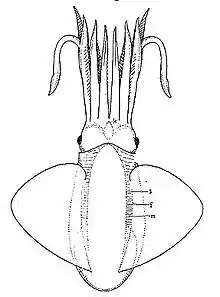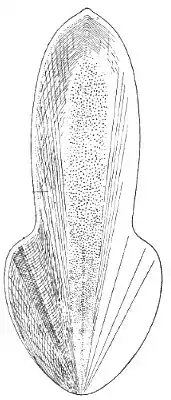Trachyteuthis
Trachyteuthis is a genus of fossil cephalopod, comprising five species: T. hastiformis, T. latipinnis, T. nusplingensis, T. teudopsiformis,[2] T. covacevichi[3] and T. chilensis.[1]
| Trachyteuthis | |
|---|---|
 | |
| Reconstruction of Trachyteuthis hastiformis | |
 | |
| Trachyteuthis hastiformis, Jura Museum | |
| Scientific classification | |
| Kingdom: | |
| Phylum: | |
| Class: | |
| Subclass: | |
| Superorder: | |
| Order: | |
| Family: | Trachyteuthididae Naef, 1922 |
| Subfamily: | Trachyteuthidinae Naef, 1921 |
| Genus: | Trachyteuthis Meyer, 1846 |
| Species | |
| |
Taxonomy
The taxonomic placement of Trachyteuthis is uncertain. Though often assigned to the order Vampyromorphida, the discovery of fossilised Trachyteuthis beaks in the Upper Jurassic limestone of Germany suggests a close phylogenetic relation to the Octopoda.[4][5] It is clear that it does at least belong in the Coleoidea.[2] It is thought to be very closely related to Teudopsis.[3]
Distribution
Fossils are scarce but have been reported from the Kimmeridge clay of the UK; the Solnhofen limestone of Germany, Jurassic deposits in Antarctica,[6] and Oxfordian deposits in Chile.[3]
History

First described in 1773 as the remnants of a fish, Trachyteuthis was considered comparable to a Sepia cuttlebone by Rüppell in 1829. A separate genus was erected for the material in 1846 by Meyer.[2] English material discovered in 1855 was termed Coccoteuthis latipinnis; this was later synonymised with the identical Solnhofen deposits. A 2007 survey of museum collection established that there were ground for the erection of three species within the genus.[2]
References
- Alberto C. Riccardi (2016). "Callovian and Oxfordian (Jurassic) teuthids (Coleoidea, Cephalopoda) from Chile". Journal of Paleontology. 90 (5): 910–922. doi:10.1017/jpa.2016.110.
- Fuchs, D.; Engeser, T.; Keupp, H. (2007). "Gladius shape variation in coleoid cephalopod Trachyteuthis from the Upper Jurassic Nusplingen and Solnhofen Plattenkalks" (PDF). Acta Palaeontologica Polonica. 52 (3): 575–589. Archived (PDF) from the original on 2012-03-23.
- Fuchs, D.; Schultze, H.-P. (2008). "Trachyteuthis covacevichin. Sp., a Late Jurassic Palaeopacific coleoid cephalopod". Fossil Record. 11 (1): 39. doi:10.1002/mmng.200700012.
- Klug, C.; Schweigert, G.; Dietl, G.; Fuchs, D. (2005). "Coleoid beaks from the nusplingen Lithographic Limestone (Upper Kimmeridgian, SW Germany)". Lethaia. 38 (3): 173. doi:10.1080/00241160510013303.
- Fischer, J.; Riou, B. (2002). "Vampyronassa rhodanica nov. gen. nov sp., vampyromorphe (Cephalopoda, Coleoidea) du Callovien inférieur de la Voulte-sur-Rhône (Ardèche, France)". Annales de Paléontologie. 88 (1): 1. doi:10.1016/S0753-3969(02)01037-6.
- Doyle, P. (1991). "Teuthid cephalopods from the Upper Jurassic of Antarctica" (PDF). Palaeontology. 34 (1): 169–178. Archived from the original (PDF) on 2012-03-24.